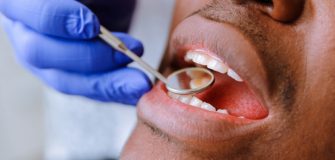Share
By Dean “The Sportsman” Greenaway
Whenever Conservation and Fisheries Officer Austin Freeman calls, whatever I’m doing, I know that I have to drop it and run.
“How quick can you get here? They’re hatching,” Austin’s voice beamed on the call. “A lot of them. Hope they’re still here by the time you get here.”
He’d given me an earlier heads up that a hatch was possible in Trunk Bay on the June 17 Full Moon. By the time I arrived, the hatchlings were already heading for the sea.
“This is rare, you don’t see this too often where they hatched on a Full Moon after being laid on a Full Moon,” Austin explained. “This is the first time I’m seeing a turtle lay on a Full Moon and hatch on a Full Moon in my 30 years. This is a rare moment that you don’t see too often.”
Tagged by Austin on Good Friday around 8:30 p.m., the six feet Leatherback laid about 60 eggs, 35 which hatched on June 17. He said typically, eggs are hatched between 58 and 62 days after being laid
“It’s kind of low for the heat,” Austin noted. “The season has been slow. We only had four turtles and seven nests. Three Trunk Bay, one Josiah’s Bay, one Rogues Bay, and one Brewers Bay. I’ve been doing this since 1989—doing volunteer work with Conservation and Fisheries when I worked at Customs—then joined them in 2014.”
While eggs are laid about three feet in the sand, Dr. Shannon Gore, Principal Consultant of Coastal Management Consulting, said the beach sand is temperature-dependent and sex-determination.
“Basically, the temperature of the sand determines the sex of the turtle,” Dr. Gore explained. “The warmer the sand, the more likely they are to be female. In terms of climate change, if temperatures are rising, you’re going to have more females.”
Atoya George, who was with her 2-year old son, hadn’t seen a hatching in four years. For the whole season, she wanted him to see the hatchling.
“It’s awesome that he gets to see what Mommy does,” said the Conservation and Fisheries Lab Technician who ensures that the coastal water quality is in good condition. “It’s important that when we do our development and different things, we don’t impact our coast beyond its ability to thrive. I make sure everything is on track when it comes to water quality. Water quality on a whole is very important when you look at animals thriving.”
Water quality, George noted, was basically taken for granted until Irma came.
“Irma opened our eyes to a lot of things, a lot of gaps that we have in the BVI,” she said. “It showed us how important water quality is because it resulted in us shutting down a beach because things were not up to par.”
Trunk Bay resident Ryan Green said he had seen turtles being released before, but never a hatching.
“We missed the turtle laying here couple weeks ago, but we’re glad we got to catch it here this evening,” he said. “We were walking the dogs, came upon it, dropped them back to the house and came back here. I didn’t realize it was going to be Leatherbacks and that’s amazing. I’ve never seen Leatherbacks here in the BVI before and the hatching is absolutely amazing.”
Sue Weaver was in Trunk Bay to watch the sunset and asked Austin if he was the turtle guy. Austin told her it was possible in a few days, then walked a little further and said, “No, they’re hatching right now.”
“I was like what? I was quite surprised,” Weaver said. “They looked as if there was a fire and their little charred heads popped out the sand. They could have been hurt if a dog was walking by.”
The number of Turtles laying and hatching was down this year over previous years, but, also offered a rare opportunity—those that we laid over the Easter Weekend Full Moon on Trunk Bay, were hatching on the June 17 Full Moon.
The first time experience was an amazing one for Samantha John and her son Devonte, who learned about the Trunk Bay laying and always wanted to expose her son.
“I actually felt sympathetic for them because they have such a tough life,” she said. “Even seeing them struggling to get to the ocean, then they finally reach and get beaten up by the waves. It was amazing but sad to see because only a few of them survive. The odds are stacked against them.”
Then on June 26, as I walked off a radio program on ZBVI, Austin called regarding a hatching on Lambert Beach. This time there were 62 being hatched and heading to the water.
“This is the most I’ve seen hatching this season,” Austin said. “This is almost a full hatch.”
As the newborn clawed their way towards the water, he explained that footprints on beaches pose challenges in turtles getting to the sea.
“They’re small and the footprints are deep—it’s like you fall into a cistern, you have trouble getting out,” he noted as he helped a few that were trapped get back on their path. “Sometimes they fall on their backs and can’t turn over and they stay there and die. Falling in a hole stops their momentum going to the sea too. By crawling into their sea, they have to get their imprint so they know where they’re born because they will return again as adults in about 25 years. If you just take them into the water after they’re hatched, they won’t return to his beach at all. Because they don’t know where they came from. Crawling to the sea is also an exercise for them to strengthen them.”
Following the passage of Hurricane Irma and the March 20, 2018 ‘swellmageddon’, Austin said it’s the most sand he has seen on the various beaches from the storm surge, giving the new turtles a longer trek to the sand.
Photo Credit: http://www.bviyachtcharters.com/sea-turtles-in-the-bvi/



